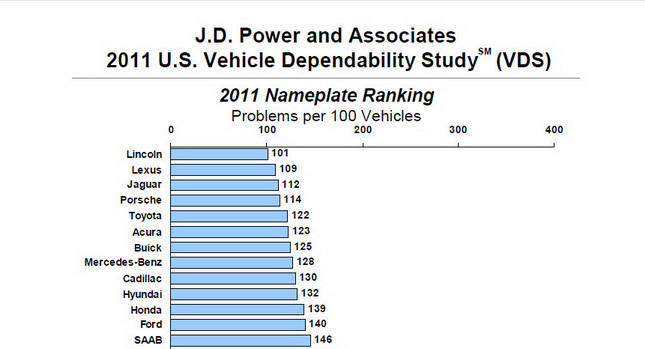Ford’s luxury division Lincoln moved up one spot in the annual JD Power reliability study to gain the title of most reliable brand sold in the U.S., ahead of Lexus and Jaguar. The industry overall vehicle dependability has also improved compared to 2010, but automakers still have problems with new technologies and features.
 The 2011 study takes into account problems experienced in the past 12 months by more than 43,700 original owners of three-year-old cars (2008 model year). JD Power determines the overall dependability by the level of Problems encountered Per 100 vehicles (PP100). A lower score reflects higher quality and the good news is the overall vehicle dependability averaged 151 PP100, the best value since the creation of the study.
The 2011 study takes into account problems experienced in the past 12 months by more than 43,700 original owners of three-year-old cars (2008 model year). JD Power determines the overall dependability by the level of Problems encountered Per 100 vehicles (PP100). A lower score reflects higher quality and the good news is the overall vehicle dependability averaged 151 PP100, the best value since the creation of the study.
With a score of 101, Lincoln was the top brand, improving by 13 PP100 from the previous year. The list with the top five brands include Lexus, Jaguar, Porsche and Toyota, with the most reliable model being the Porsche 911, with only 68 problems per 100 vehicles.
Seven Toyota-made cars came first in their segments, the most victories for an automaker: Lexus RX, Scion xB and the Toyota-branded 4Runner, Prius, Sienna, Tacoma and Tundra. The Japanese automaker was followed by Ford Motor Company, with four models (Ford Fusion, Ford Mustang, Lincoln MKZ and Lincoln Navigator). Next came GM (Buick Lucerne, Cadillac DTS, and Chevrolet Tahoe) and Honda (Acura RL, Honda CR-V and Honda Fit). Other cars that topped their categories were the BMW X3 (although the brand ranked below average), the Mazda MX-5 and the Mercedes-Benz CLK.
Even if the industry is showing overall improvements in reliability, JD Power stresses that automakers register an increased rate of problems with electronic features such as audio, entertainment and navigation systems, as well as with new safety features, such as tire pressure monitoring systems.
“Automakers, as a whole, have made significant improvements in reducing traditional problems, particularly with vehicle interiors; engines and transmissions; and steering and braking during the past several years,” said David Sargent, vice president of global vehicle research at J.D. Power and Associates. “However, as manufacturers add new features and technologies to satisfy customer demand and new legislation, they face the potential for introducing new problems,” he added.
Scroll down to take a look at the winners and losers of JD Power’s 2011 U.S. Vehicle Dependability Study.
By Dan Mihalascu
Source: J.D. Power
JD Power’s 2011 U.S. Vehicle Dependability Study

 _______________________________________________________________________
_______________________________________________________________________
PHOTO GALLERY

























